|
|
Post by Reptisaurus! on Dec 16, 2014 22:38:49 GMT -5
Sandman # 68 May 1995
The first comic I bought as a grown-up after a couple year hiatus - Although even MORE important was the volume of the Dolls House TPB I read in the Tattered Cover bookstore in Denver, Co. I had moved away from home to work for Americorps a couple months back, and was listlessly trying to avoid my roommate. I was flipping through the comics, sat down, and went "Holy #$% this is GREAT!"
As for Sandman # 68 marked my (A) first purchase of an "adult" comic, (B) my return to collecting, and (C) had a Marc Hempel drawn scene where the spirit of Delerium meets the Devil at a piano bar in LA, which is still one of my favorite 4 pages of comics ever.
|
|
Polar Bear
Full Member
Married, father of six
Posts: 107 
|
Post by Polar Bear on Dec 19, 2014 17:12:45 GMT -5
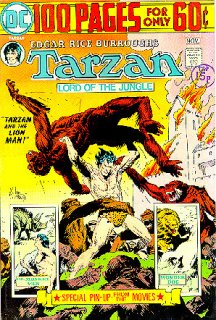 Day 2: Tarzan (DC) #233, anthology issue, 1974 Ah, this is the life. We start out with a great Kubert cover and a lead 18-page Kubert story. Then, we get "The Land that Time Forgot" by Russ Manning, running a full 21 pages! After a six-page Silver Age reprint with art by the under-appreciated Leonard Starr, we get an all-too-rare Rex, the Wonder Dog ten-pager with Gil Kane artwork, followed by a pair of six-pagers (Detective Chimp by Infantino and Congo Bill by Smalle). Rounding out the volume is a Korak story with eight pages from the ever-experimental Alex Nino. Add in a few pages of animal facts, movie trivia, and letters pages, and this is the type of comic you simply can't find on the stands--or the stores--anymore. |
|
|
|
Post by thwhtguardian on Dec 19, 2014 17:52:16 GMT -5
I have that issue, and it almost made my list! I'm a huge Kubert fan.
|
|
|
|
Post by Calamas on Dec 19, 2014 18:38:37 GMT -5
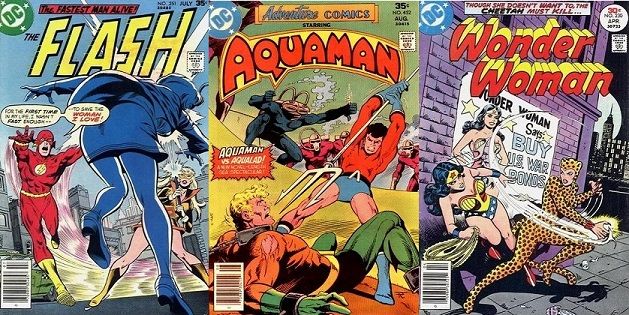 The Flash #251 July 1977 “Vengeance on Ice” Cary Bates Irv Novick Joe Giella Anybody who has read this comic would immediately know this could only be a sentimental choice. You’d be right. The comics above were my first. I’d read comics before (Doctor’s offices and such) but this is where I discovered that any three comics were more entertaining than any hour of television. At least until Wonder Woman #233, where I learned there was good and bad in every art form. That afternoon I was looking for characters I had heard of but not the ones everybody knew (Superman, Batman, Spider-Man, etc.) As everybody here could understand, these choices changed my life. Only in terms of how much I’ve spent since, if nothing else. I’ve always listed The Flash first. I believe now it’s because of Story. Michelinie’s Aquaman story was adventure based (perhaps intentionally so; it appeared in Adventure Comics, after all). Pasko’s Wonder Woman was focused on creating a superhero dynamic in the WWII era the Lynda Carter TV show had forced upon the comic. Cary Bates, as best I could tell, loved villains and plot twists. For plot twist to work, there had to a setup, and that meant something had to happen. Story. There was a lack of story in other forms of entertainment at the time. It could be argued there is lack of story in comics today, for better or worse. In 1977 it filled a need that has, for the most part, kept me around to this day. For better or worse. |
|
|
|
Post by Icctrombone on Dec 19, 2014 22:06:20 GMT -5
#11 Superman 252 100 pg Spectacular My #1!!! Cei-U! Great minds...! Cmon, SPOILER ALERT !!!!!  |
|
|
|
Post by Paradox on Dec 20, 2014 2:26:34 GMT -5
11. X-Men #94 (Marvel, August 1975)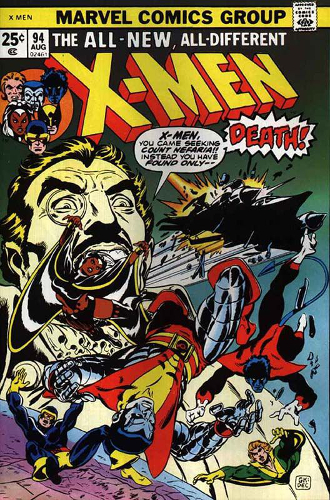 I had always been a fan of the X-Men. #6 was one of the first comics I ever read. I enjoyed the "teens struggling to be accepted" angle and they had cool powers, and even cooler enemies. It had very much solidified during the Thomas/Adams era, and afterward I religiously followed the reprints, filling in a lot of what I didn't have. Then this one came out. Hokey smokes, it was great! Old members out, new members in (and I remember thinking "when did Sunfire start wearing a frog mask?"). And all drawn by one of my favorites at the time, Dave Cockrum, whom I'd nearly idolized on Legion of Super-Heroes and Avengers. And not all American white guys for a change! Lots of different personalities and the room for growth new characters afford. Frankly, it hit me a lot like the Legion had originally. I love variety/diversity! Grocery store distribution being what it was back in those days, I hadn't even SEEN the new Giant-Size earlier that year, so this was my true introduction. I loved it so much it prompted me to write my first letter to a comic. I filled two pages with my scrawly penmanship, mostly praise with a mention of how badly they'd telegraphed who was going to die by not putting Thunderbird in the "circle of heads" by the price. But...this book didn't have a letters page yet, just coming off a reprint run. Where do I send it? Ah, here's an old Adams X-Men, I remember that had a letters page. So off I sent my first missive. And got it back a few weeks later, all marked up with "undeliverable" and "no longer at this address". Crap! Sometime between those Adams issues and 1975, Marvel had moved across town and I'd had no idea. And by that time the new issue was out, and it seemed pointless to sent it to the right address at that time, so my first writing attempt went into the circular file, like many first attempts do. Sadly, those two issues were the last I'd see of them for a while. Distribution hammered me again, not seeing another issue until #101. But I read and read and reread those two issues until the covers were falling off!
|
|
|
|
Post by berkley on Dec 20, 2014 3:40:29 GMT -5
11. X-Men #94 (Marvel, August 1975)I had always been a fan of the X-Men. #6 was one of the first comics I ever read. I enjoyed the "teens struggling to be accepted" angle and they had cool powers, and even cooler enemies. It had very much solidified during the Thomas/Adams era, and afterward I religiously followed the reprints, filling in a lot of what I didn't have. Then this one came out. Hokey smokes, it was great! Old members out, new members in (and I remember thinking "when did Sunfire start wearing a frog mask?"). And all drawn by one of my favorites at the time, Dave Cockrum, whom I'd nearly idolized on Legion of Super-Heroes and Avengers. And not all American white guys for a change! Lots of different personalities and the room for growth new characters afford. Frankly, it hit me a lot like the Legion had originally. I love variety/diversity! Grocery store distribution being what it was back in those days, I hadn't even SEEN the new Giant-Size earlier that year, so this was my true introduction. I loved it so much it prompted me to write my first letter to a comic. I filled two pages with my scrawly penmanship, mostly praise with a mention of how badly they'd telegraphed who was going to die by not putting Thunderbird in the "circle of heads" by the price. But...this book didn't have a letters page yet, just coming off a reprint run. Where do I send it? Ah, here's an old Adams X-Men, I remember that had a letters page. So off I sent my first missive. And got it back a few weeks later, all marked up with "undeliverable" and "no longer at this address". Crap! Sometime between those Adams issues and 1975, Marvel had moved across town and I'd had no idea. And by that time the new issue was out, and it seemed pointless to sent it to the right address at that time, so my first writing attempt went into the circular file, like many first attempts do. Sadly, those two issues were the last I'd see of them for a while. Distribution hammered me again, not seeing another issue until #101. But I read and read and reread those two issues until the covers were falling off! I didn't get into the Claremont X-Men until #99, but I had a similar reaction. For me it never ranked with the very best comics Marvel produced in the 70s, but, to paraphrase Somerset Maugham, it was at the very top of the 2nd rank. An excellent traditional Marvel superhero team series, probably the best of its time (the 1st rank being occupied by series that went beyond the traditional Marvel superhero team, like Englehart's Avengers and especially Gerber's Defenders). Like you, I was very attracted to the idea of the international cast - it was always a bit weird as a kid, reading American comics - and pretty much nothing but American comics, until Heavy Metal came along in my later teens - when you weren't American yourself, and a superhero team whose members came from all over the world was such a breath of fresh air that it appealed to me at an almost subconscious level. Too bad the Canadian character was so annoying. I would have had Arkon kick the crap out of him in that Annual, if I'd written it (oops, sorry - flashing back to a different issue). But at least there was one - Canadian character, I mean - even if he was a jerk. But it was of course the combination of Cockrum's, and later Byrne's, artwork and Claremont's writing that gave the series its staying power. Just a really solid superhero series, that you might say epitomized the Marvel superhero team, at the time. I loved Claremont's soap-opera, relationship drama sub-plots and his elevation of Magneto to an adversary of much grander stature than had previously been the case. The magic only lasted for about 40 issues for me - but that was a solid 3+ years of exceptionally engrossing superhero comics. |
|
|
|
Post by Deleted on Dec 21, 2014 23:50:06 GMT -5
11. Ravage 2099 #1 Dec. 1992 Written by: Stan Lee Penciller: Paul Ryan 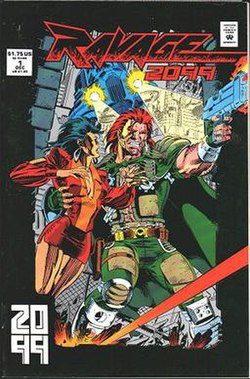 Plot: Paul-Phillip Ravage, CEO of ECO, is framed for murder, and forced to go on the run from the corporate cops of Alchemax. We get introduced to Dack, who seems like he could be a sidekick, but never appears agao, and Tiana, who would be Ravage's actual sidekick/love interest for the rest of the series. Why I picked it: Y'all know I'm a 2099 fan (hence the profile pic). 2099 started in comics just as I did, I was pretty excited when not only was there a new universe starting up for me to get in on, but Stan Lee was creating it! I was super excited. Of course, the comic itself isn't all that great, it's starts out as an enviornmental parable, but quickly becomes a Wolverine clone. I really like the early art though (Paul Ryan) What I really liked was the idea of a spin-off future Marvel Universe. At first, they did a great job creating new character for it.. Ravage was all original, Miguel O'Hara was pretty different as Spidey, and the X-Men, while still mutants, had no relation to the current ones other than the name. Then there's Doom, who was just awesome. ON top of that, they had GREAT creators... I quickly realized I liked PAD and Warren Ellis (though the latter has since gone of the rails, IMO)... it was really the first time I paid attention to creators, to be honest. I think it all went off the rails when they tried to tie it to the present with the Fantastic Four, and started killing people off (just like the Ultimate universe, incidently... no lesson learned). Of course, Hulk and Ghost RIder were pretty medicore, too, but that's another story. Historic Significance: Ravage was the last Stan Lee creation at Marvel, as many know. Funny, I know I'm not the only fan out there, (since there's now a new Spidey 2099 book) but 2099 really only lasted 4 years... maybe 5 if you count the horrendous 'World of Tomorrow' series. Wow. So Stan Lee created this? You've really piqued my curiosity. I'm going to have to check this out. |
|
|
|
Post by berkley on Dec 22, 2014 2:26:22 GMT -5
New Gods #1
December 1970 (cover date Mar 1971) read sometime in the late70s  My list is roughly in chronological order of when I first read the comic, from most recent to earliest, so I think this is about the right spot for New Gods #1 - after all these years of re-reading it in various formats, I'm no longer sure. I missed all of Kirby's DC work when it first came out and only began to track down the odd back issue some time after his return to Marvel. For a long time, until the Baxter reprint series of the early 80s, this was the only New Gods comic I had read, and even this one not in complete form. Be that as it may, I was immediately knocked out by the epic quality of the imagery and, yes, the writing:  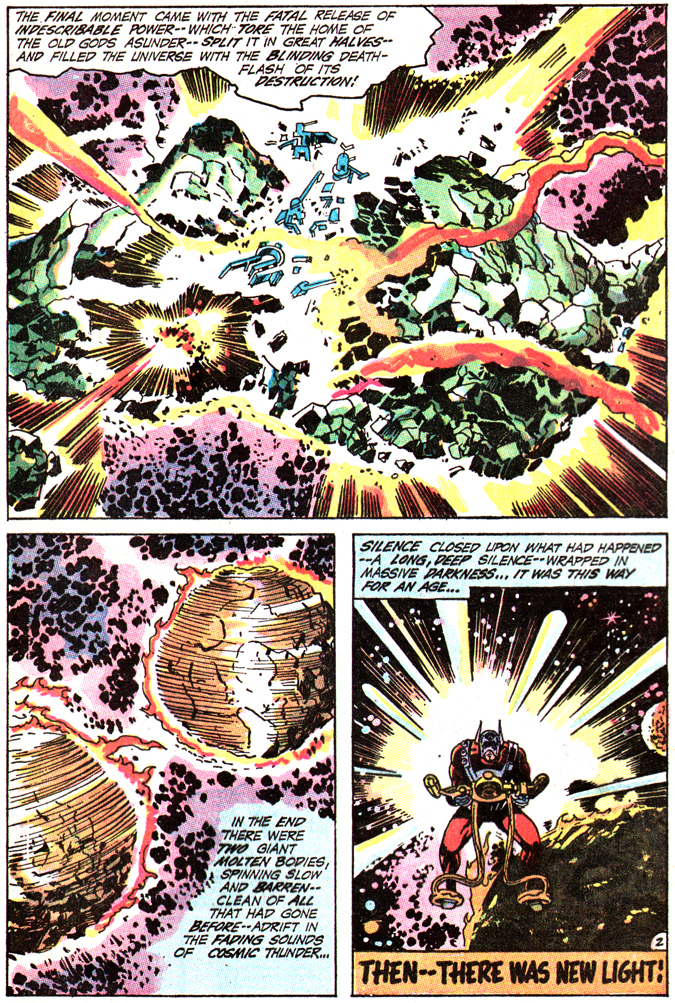 I'm not saying it's perfect, but I do say that it gets the point across and succeeds admirably in maintaining a heightened sense of drama and importance without falling into an absurd kind of pomposity. Not many writers today could have done better. And I'll go farther and say that no writer today or at any other time could have improved on some of the speeches and captions in which Kirby evokes his characters' essence in just a few words. NG#1, page 3:  Orion has heard the word and the word is BATTLE. Orion FIGHTS for earth (BTW, later reprints messed with this caption and failed to use a different colour for "fights", lessening the impact). A few pages later, with Orion on Apokolips and under attack by a troop of Parademons,: "It is suicidal to run from them! My only chance to live - is to attack!" And there you have Orion in a nutshell: "Battle, fight, attack". More: with him, to be alive, is to attack, to fight - because he isn't an ordinary, mortal fighter, or even a superhero - he's a god - a New God. And as we read in a later issue, "The Gods are ever near - a part of men's lives. Giant reflections of the good and evil that men generate within themselves." IOW, he isn't just some guy who likes to fight, he is in some sense the very essence of fighting, of attack, of battle - and, at least from the standpoint of Apokolips (and as is stated explicitly in the last issue of Mister Miracle), of destruction. But wait, it's not quite that simple. The strange path his life has taken means Orion is not just a mindless engine of force and destruction - he'd just be another Kalibak if that were the case. No, this embodiment of strife and combat, somehow or other and against all odds, is one of the New Gods of peaceful New Genesis. And it's taken a tremendous struggle for him to subdue his frightening Apokoliptan nature to something that can accept and be accepted by his chosen world - because it was and continues to be a choice. This is hinted at - telegraphed, really - right from the first few pages of NG#1. All this comprises the very core of the character, so it really does sadden me when I see writers cavalierly ignore or change any of it for the sake of a joke or trying to make some superhero look cool. It happens over and over again, and every time I come across another instance it makes me lose one more bit of respect for that writer. I try to avoid commenting on every appearance because I inevitably come across as a hater (which is fair enough - I do hate it, for the reasons given), and really, I should know better by now than to look at these things at all, let alone to try to convince Wonder Woman or Superman readers that a valuable character is being written badly). (to be continued)
|
|
|
|
Post by berkley on Dec 22, 2014 2:39:38 GMT -5
![]() Anyway, I got a little sidetracked talking about the much misunderstood (by DC writers and fans, at least) Orion. Getting back to NG#1 in general, not all of it works perfectly: for one thing, Vince Colletta's inks had deteriorated drastically from his work a few years earlier with Kirby on Marvel's Thor, and some of the panels look a little sparse and sketchy, with little or nothing in the way of background detail - though who knows, maybe some of that was down to Kirby creating, writing, and drawing three or four new series at the same time, all by himself. So not all of the artwork is as arresting as the few pages I've posted here. And then ... Hmm, after all my ranting I wanted to provide some balance but I can't actually think of much else I'd criticise in a negative sense. The whole thing felt so intriguing and so big; the biblical echoes (the Moving Hand; "THEN - THERE WAS NEW LIGHT!"; etc) were so odd and yet so effective. And I'll tell you another thing: people say Kirby's writing was bombastic and simplistic, even crude, but for me, not only does he succeed in raising the tone of his narrative to an epic level without being silly (given the comic book context within which he was working) far more than almost any other comics writer I can think of, I find he often displays more subtlety, more of a fine touch than many another comics scribe held up by fans as an example of a more sophisticated style or sensibility. Here's the last page of New Gods#1, the "prologue" that bookends the opening "epilogue":  He's responding to a challenge Orion made in the last panel of the previous page ("Darkseid I have come [to earth]! The battle begins!" ) - but the thing is, in that preceding panel there was no sign that Orion was actually speaking directly to Darkseid - the Boom Tube that brought him and the earth people he'd rescued from Apokolips to earth had already closed and disappeared, so it seemed to be a purely rhetorical statement on his part. But then you get the full-page response from Darkseid on Apokolips, "I hear you Orion! the battle begins!", with no sign of any technology or anything that might be enabling them to carry on this exchange. It's one of a few times in the series where Kirby gets across to the reader that these are not just superpowered aliens, there's something different, something more, going on here. These are archetypes speaking - a Grant Morrison might say they were speaking to each other through the very medium itself in which they live - the comic book page and our, the readers', minds - a medium inaccessible for use in this way to other characters in the story. Now look at the expression on Darkseid's face: it's typically (in the original Kirby books) calm and impassive, as is his speech - characteristics shared by Orion, not coincidentally. Both are, in different ways and for different reasons, all about control - yet another point lost on supposedly more sophisticated writers who habitually write Darkseid as a pompous ranter and Orion as a crude bully - or, in the recent Wonder Woman, as a petulant fratboy. Darkseid obviously is striving to control all reality to an even greater degree, at an even more fundamental level, than he does Apokolips. But he is also all about self-control in his quest to achieve that end. Orion too is all about self-control - in his case, of his menacing Apokoliptan nature. In a way, he's the opposite of a Batman who works to project a frightening image to his criminal enemies. Orion's problem is that he is all too frightening just by being who he is, and he has to work hard not to be - to the point of changing his face. That's one of the poignant aspects of the character - to me, anyway. I haven't seen any writers pick up on this very basic idea since Kirby presented it in his original series. They've kept the part about Mother Box disguising his real face, but dropped the subtlety and tragedy of the motivation behind it. Because of the ridiculous changes to his personality in the recent WW, for example, he came across more as Michael J. Fox in Teen Wolf than as the reverse Jekyll/Hyde Kirby gave us (a Mr. Hyde who's trying to change into Dr. Jekyll). Ah well, I can see I'm slipping back into ranting mode again, so I'll put a stop to this now. At least all this blithering has probably gotten across that this comic and later the entire - what should we call it? series, plural; what? - it was so far ahead of its time we still haven't invented a name for it yet, it seems - that the entire whatever-it-was made a huge impression on me, and hence its place here in my reverse-chronological list of favourite comics. |
|
|
|
Post by badwolf on Dec 22, 2014 13:08:54 GMT -5
 The Flash #251 July 1977 “Vengeance on Ice” For some reason that's the only issue of Barry Allen's Flash that I ever owned. Not sure why, but it did make me fond of Captain Cold, and I was upset to find out that his sister had been killed off later. |
|
|
|
Post by MWGallaher on Dec 23, 2014 15:52:42 GMT -5
11. Marvel Graphic Novel #13: Starstruck by Elaine Lee and Mike Kaluta Starstruck was one of the richest, densest comics I had ever read when I picked this up in the mid-80's. I had never really gotten into Heavy Metal, where portions of this had first appeared, and I admit that my first read-through of this left me befuddled. I got the general idea, but there was so much going on, so many details in this world, so many curious characters whose nature wasn't just spelled out for me--this was an adult piece of fiction, not just a simple story being told in a straightforward way. Starstruck, out of any comic I'd yet to find, gave me more "bang for the buck": Every time a new issue came out, I'd read it, then go back to this graphic novel and read the entire story so far. I think this may have been my first comprehension of the possibility that sometimes in fiction, knowing what's going to happen next makes the reading better, not worse. As a work of visual art, well, it's Mike Kaluta, doing work on something that he is personally invested in. It's gorgeous. Every blasted panel is gorgeous, inviting, and reveals layers of story, atmosphere, history, motivation and action. Writer Elaine Lee didn't have much experience in conventional comics, and it shows: Marvel and DC writers of the era didn't tend to make a reader work for his reward. Lee's attitude seems to be "If you didn't get it, read it again, and pay more attention this time." I got into a CBG letters page debate with Don Thompson over this book. Don contributed a lot to comics fandom, but he didn't seem to want comics to rise above superficiality. He compared this to a Ukrainian Easter egg, with lots of layers but nothing of substance inside. Boy, was Don wrong...just this first installment had more story content than 3 years of contemporary Spider-Man adventures.
|
|
|
|
Post by Deleted on Dec 23, 2014 20:29:17 GMT -5
11. Eerie 1970 Yearbook Summer 1970 Warren This is the only addition to my original 2005 list that didn't occur to me at the time ... but when I remembered it a few years after that, I simply couldn't omit it. Not for nothing did two of the stories here, Archie Goodwin & Angelo Torres' delectably Lovecraftian "Soul of Horror" & Tom Sutton's take on Poe's "Masque of the Red Death," appear on my Halloween best-of a couple of months back. At least one more was a strong contender as well -- Goodwin & Steve Ditko's "Shrieking Man." Not that the other strips were anything but gems, either. One heck of a horror collection, & my only non-'60s selection (though of course all the stories were reprints from then). 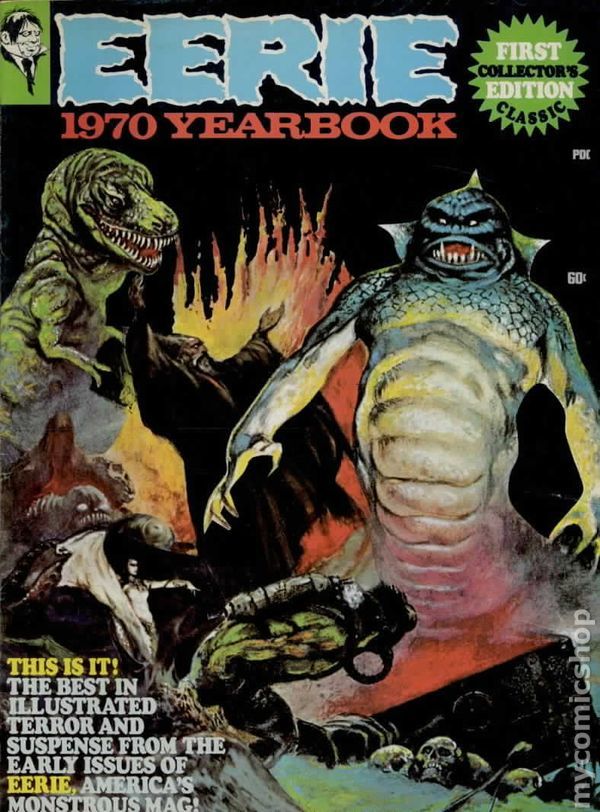 |
|
|
|
Post by thwhtguardian on Dec 23, 2014 20:50:43 GMT -5
11. Eerie 1970 Yearbook Summer 1970 Warren This is the only addition to myt original 2005 list that didn't occur to me at the time ... but when I remembered it a few years after that, I simply couldn't omit it. Not for nothing did two of the stories here, Archie Goodwin & Angelo Torres' delectably Lovecraftian "Soul of Horror" & Tom Sutton's take on Poe's "Masque of the Red Death," appear on my Halloween best-of a couple of months back. At least one more was a strong contender as well -- Goodwin & Steve Ditko's "Shrieking Man." Not that the other strips were anything but gems, either. One heck of a horror collection, & my only non-'60s selection (though of course all the stories were reprints from then).  This nearly made my list, excellent choice. |
|
|
|
Post by Deleted on Dec 24, 2014 10:01:32 GMT -5
The very fact that such a thing almost certainly exists makes me quite grumpy. Are you a Kerouac fan, benday? I am, but I've not seen the On the Road movie yet. I'm dubious because it's not as if On the Road is actually that good a story or anything; it's the language and the rhythm in which it's written that makes it so breathtakingly good. I'm not sure how you could possibly translate that onto the movie screen. Alas, such a thing does it exist. I happened to see it it the bookstore just the other day, much to my dismay. I guess publishers think the image some contemporary celebrity is necessary to sell a book like On the Road, because you know it's not like Kerouac can write or anything. Likewise, I haven't seen the movie either. My assumption was/is that it would suck and be so far removed from the brilliance of the language you rightly remark upon that there would be little point. Was it Truman Capote who said that On the Road consists of typing, not writing? |
|